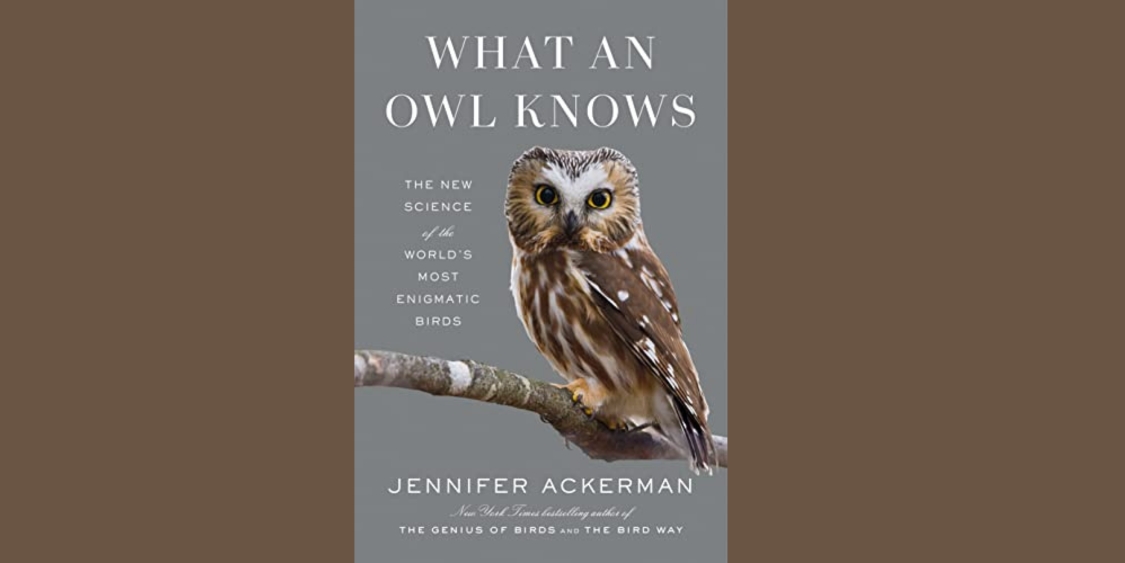Review by John McFerrin
This is a book about owls—where they live, what they can do, threats they face, and folklore about owls. The West Virginia Highlands Conservancy is blessed to have some real bird brainiacs among its members, people whose knowledge of birds is awesome. I think it is safe to say that not even they know nearly as much about owls as is in this book.
What owls can do is jaw-dropping. Some can see light in a part of the spectrum that is invisible to humans. Some have hearing so acute that they can hear a vole moving under a foot of snow; they can track its movements well enough to know the exact time and place to pounce. They can form such a precise mental picture of a place that they can find their way even in complete darkness. Snowy Owls can survive in temperatures forty degrees below zero (the number of feathers they need to be able to do this makes them one of the heaviest owls).
There is even a possibility that some owls can see sound. There are neural pathways that lead to parts of the brain that process sound, enabling hearing. In some owls, the neural pathways that usually lead to hearing parts of the brain end up in the seeing parts. It may be that the sounds an owl hears are being processed into a visual image that makes hunting more precise. Whether this is true or not is unknown and probably unknowable. It is hard enough to catch an owl, much less have it sit for an interview.
The book explains why owls can fly without making any noise. Much of the noise in other birds’ flight comes from the air passing over their wings. Owls have fine ridges on some of their feathers that break up the air. This gives owls the ability to fly silently, giving the appearance of magically appearing when nobody heard them coming.
There is some dispute among researchers on the purpose of silent flight. Some contend that it is so that prey cannot hear them coming. Others contend that it is because owls depend so much upon their hearing in hunting. They cannot be distracted by any noise their wings make. This controversy is unresolved; maybe it is both.
There are lessons about ecology as well. Many species of owls are cavity nesters. They can’t make their own cavities. For that, they depend upon the presence of woodpeckers. It is easier to create cavities in certain tree species. An abundance of that species means lots of cavities, lots of owls. In many places, an abundance of owls depends upon whether it is a good year for cones. Plentiful cones means plenty of small mammals. Plenty of small mammals means plenty of owls.
Much of the book is about research into owls and owl behavior. This inevitably leads to stories about owl researchers. Because most owls are nocturnal, they depend upon sound for courtship, territorial defense, etc. Owl researchers spend a lot of time in the woods with their recorders, listening. One of the legendary owl researchers came to owl research after musical training and one career as a professional musician. With her lifelong orientation toward sounds and the nuances of sound, she was as close to an owl as any human could hope to be.
One of the things that make owls difficult to study is that they are difficult to see. Although they have the talons to make them formidable fighters, their first line of defense is camouflage. They are masters of looking like a broken tree branch, a lump, anything to make themselves invisible to predators (the goal) or researchers (an incidental result). The difficulty in studying owls results in many things about owls being unknown.
The natural history of owls was most interesting to me. In addition to chapters about the natural history, there are chapters on folklore surrounding owls, the role of owls in our ecosystem, and threats to owls (habitat loss, climate change, pesticides).
The threats section introduced me to what has to be the greatest acronym of all time: RATS (Raptors Are The Solution). It advocates for reduced use of poisons to kill rats and mice, suggesting that birds of prey such as owls, hawks, etc., can take care of the problem. It’s a real thing: website, Facebook page, the works. Look it up.
From a glance, it might be possible to conclude that this book would tell you more about owls than you really wanted to know. This is absolutely not true. The book is entertaining from beginning to end. While it tells a lot, it is not wearing and definitely does not tell you more that you want to know. The author has an obvious affection for owls, has done a lot of research, and has an engaging writing style. There is no danger that you will get part way through and decide you are sick of owls.
One omission: the chapter on owl folklore does not mention the episode of The Andy Griffith Show where a superstition about an owl was a key plot point. But nobody’s perfect.

